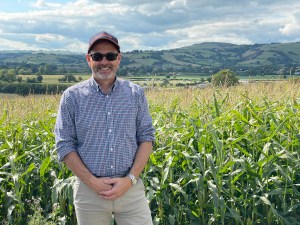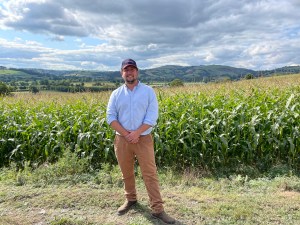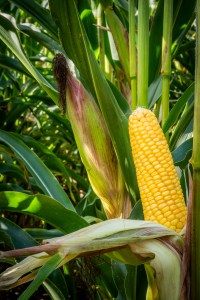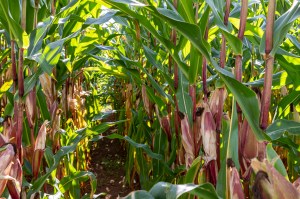Written by CPM Magazine from CPM Magazine
Download PDF
It’s been a tricky year for maize growers, but despite this, harvest has wrapped up early. So what should growers keep in mind ahead of next year? CPM looks at the coming season and some of the new varieties on the market.
By Melanie Jenkins
There’s been few forage maize crops that have had an easy ride of it this season, with drought conditions leading to stunted growth and some crops hardly hitting a metre in height. And yet, some less favourable sites have produced fantastic crops. So what happened?

Ellie Sweetman highlights that regardless of the season, it’s important to sow into warm soils and not let seeds sit in a cold seedbed.
It hasn’t just been this year that has presented challenging conditions but the past few years, from prolonged droughts alongside high temperatures to very wet conditions and significant levels of lodging, according to Ellie Sweetman of NIAB. “This year we had a cold spring which delayed sowing on some sites and it took a while for soils to warm up.”
It’s been a really difficult season, agrees Andrew Cook of KWS. “Growers had to contend with 2022 presenting the polar opposite season to what they dealt with in 2021. Some of the favourable sites have really struggled with a lack of moisture and extreme heat, especially where there was later sowing after rye or grass, and yields have been disappointing.
“But the less favourable sites have retained moisture better and it’s almost been a perfect year for them as they’re in cooler areas. So yields have ranged from really disappointing to really pleasing – a complete spectrum,” he adds.
And the summer didn’t just impact commercial crops, but trials too, according to Ellie. “Where there was severe drought, lighter soils and not much moisture, this resulted in some stunting. Luckily there was enough moisture to produce cobs but the total dry matter (DM) was down.”

It’s been an almost perfect year for less favourable growing sites, according to Andrew Cook.
One thing for growers to keep in mind for next year is that there’s likely to be some issues with seed availability, says Andrew. “The drought here and across Europe has affected the main maize growing areas, so we are encouraging growers to order early.”
Hutchinsons, which runs its own set of trials across the country to produce a list of suitable varieties for growers, has also had difficulties this year. And although the firm will produce its maize portfolio, there may be a shortage of certain varieties next year, says Peter Brundle of Hutchinsons. “There’s been a shortage of forage this year, so there’s a big demand for maize and we’re expecting to see a price rise because of this.”
So if the maize season presents such differing conditions each year, what can growers do to help manage this volatility.
Ellie highlights that regardless of the season, it’s important to sow into warm soils and not let seeds sit in a cold seedbed as this will impact germination. “As a general rule, soils want to be 10˚C at a depth of 10cm as this means the soil biology is active. And there should be enough moisture to allow seeds to start germinating.”

Hutchinsons is expecting a shortage of some varieties next year because of the drought across the UK and Europe, says Peter Brundle.
But it’s not just about the amount of moisture, it’s also the timing of it, she adds. “The really active growth of the crop is happening at speed in June and July, so it really wants moisture then.”
According to Ed Porter of Hutchinsons, nutrition is key. “A starter fertiliser can be critical to getting maize off to a good start. Using a micro granular fertiliser with protected phosphorous means the nutrients are available as the plant grows rather than getting locked away in the soil.

Ed Porter points out that about 50% of the nitrogen requirement for maize comes at the cob fill stage.
“And as about 50% of the nitrogen requirement for maize comes at the cob fill stage, a lot of early applied N may have been lost by this point. So applying slow-release methylene urea at the latest point you can get it onto the leaf can mean a 20-50% yield increase.”
This is one reason why high organic matter (OM) soils do particularly well, especially if growers are using farmyard manure or slurry, adds Ellie. “This is because the timing of the release of N coincides with the most active growth period of the crop.
“Interestingly, work by the Maize Growers Association (MGA) is currently reviewing whether artificial applications of N on high OM soils at the RB209 recommended rates are perhaps higher than they need to be. So far it does suggest there are opportunities to reduce N rates, but the research is still on-going,” she adds.
One of the most critical elements NIAB finds when getting trials set up well, is a good and appropriate use of pre-emergence and post-emergence herbicide, if required, says Ellie.

LG Maize for animal feed photographed by Ioan Said Photography.
According to Tim Richmond of Limagrain, it’s important to not cut corners with nutrients, preparation, timeliness or having enough OM in the soil. “It’s about care and attention and having the end user of your crop in mind.”
Another option growers may want to consider could be to undersow maize with something like ryegrass, suggests Ellie. “Maize can be undersown when it has about six leaves in strips between the rows to avoid competition. The undersown crop ticks over and might not look impressive, but once the maize has been harvested this crop will get sunlight and will mop up any N sitting around. It’ll then provide good soil cover and structure, particularly in fields where maize is grown each year.”
According to Andrew, the best option to manage volatility is to look at the five-year average performance on farm. “This will hopefully help you see which variety will perform year-on-year. So don’t be too reactive to this season as a standalone.”
And although growers may find a particular variety which performs on farm and is consistent, there’s a lot to be said for moving onto newer varieties. These provide incremental advances in yield and nutrition that can make a difference to the return on investment, explains Ellie “By raising the bar with the newer varieties, productivity increases but inputs should be remaining static so inevitably the nutrient use efficiency should be continuing to improve.
“If you’re spending money on cultivations and establishment then you want to know your investment will get a return, or that you’ll have enough forage – particularly in years like this one. So it makes the drive for efficiency even more poignant.”
If growers continually stick with older varieties, after a period of time they might be losing out on yield and quality, says Tim. “It’s totally understandable that growers want to stick with what works for them, but as breeders, we’re bringing new genetics to the marketplace that over time are producing a yield advantage of 1-2% every year, as well as quality improvements in starch, digestibility and global energy output. If growers don’t change varieties for a number of years, they could be missing out on quite large increases in energy yield.”
Tim also highlights that newer varieties are often earlier maturing, meaning a shorter grower season. “If maize is in rotation with wheat or growers want to put cover crops in, maximising maize production in a shorter period is advantageous. Plus, maize has had a lot of bad press in the past due to soil damage that can be caused by harvesting later in wet conditions, so the earlier growers can get it off the field, the better.”
Andrew concurs: “Although you might have a favourite variety, it’s always worth trying a small area of something new because if there are any production issues with varieties, or they come to the end of their commercial life, you can move on with confidence. It’s important to keep looking forward.”
With ‘looking forward’ in mind, the BSPB 2023 Forage Maize Descriptive List (DL) has recently been released, detailing the first and second choice varieties for favourable, less favourable and very favourable sites. Although NIAB doesn’t yet have the data from this year’s trials, the published tables depict an amalgam of the past four-five years’ worth of data, explains Ellie.
She advises growers to be aware that what’s presented on the list in terms of yield and DM content may not be replicated on their sites, so it’s important to know which fields are ‘favourable’ or ‘less favourable’ sites. “The MGA and NIAB have produced tables so that you can work out which your site is based on factors including soil type, topography and location.”
Once growers know what type of site they are working with, the DL can help them select a suitable variety, she adds.

Of the new varieties on this year’s Descriptive List, the early maturing variety LG Saxon came out as the highest yielding variety for favourable sites.
Of the new varieties on this year’s list, the early maturing variety LG Saxon – from Limagrain – came out as the highest yielding variety for favourable sites at 19.8t DM/ha, a metabolisable energy (ME) yield of 231,000MJ/ha and starch yield of 6.5t/ha. However, it has some susceptibility to eyespot which is only an issue in damp growing seasons, explains Ellie.
KWS Anastasio is the next highest yielder at 19.6t DM/ha, an ME yield of 226,000MJ/ha and starch yield of 6.26t/ha, with good standing power and eyespot resistance, she says.
Anastasio is a later maturing variety, adds Andrew. “As it’s slightly lower in starch, it’s suited to a higher maize inclusion diet and can be used as corn cob or as crimped and dried maize, as well as biogas production.”
And of note is KWS Pasco, which has the highest starch yield across the entire DL at 6.66t/ha, plus a yield of 19.3t DM/ha, good standing power and eyespot resistance, adds Ellie. “Pasco also sits on the less favourable site list with a yield of 19.0t DM/ha at 33.4% DM, starch at 34.6%.”

Debalto, a second-choice variety which sits on the DL for both favourable and less favourable sites, falls into the very early maturing section.
Debalto, a second-choice variety which sits on the DL for both favourable and less favourable sites, falls into the very early maturing section, according to Andrew. “It delivers some great yields, just shy of 19t DM/ha and has starch levels of 34.2% and 219,000MJ/ha of ME on favourable sites, which is a lot of yield for its earliness.”
According to Peter, Debalto may not have made first choice on the DL because it looks like it might lodge. “However, we haven’t seen it lodge this year.”
LG Dignity and Saxon – both Limagrain varieties – yielded well on less favourable sites at 18.7t DM/ha and 18.9t DM/ha respectively, and starch levels at 33.6% and 33.4%, but both have some susceptibility to eyespot, says Ellie. “Dignity is the earlier maturing of the two with 35.1% DM at time of harvest, while Saxon produces 34% DM. Both have good early vigour, so would be suitable for good quality silage in more challenging growing conditions.”
Dignity is a very early maturing variety, according to Tim. “It has an FAO maturity of 170, while Saxon is a little later at 180. Dignity has looked good on farm and has been one of the highest yielders in trials this year, and Saxon has performed pretty well too.
“Both varieties are suited as livestock feed, whereas Saxon is good for anaerobic digestion or for those wanting to cash out by maximising yield,” he adds.
Of the three varieties added to the ‘very favourable’ DL, Smoothi CS is the highest yielding at 19.5t DM/ha with a good ME yield, good early vigour and good standing power, explains Ellie. “Abrisse is the earlier maturing at 35.5% at harvest, with a yield of 18.6t DM/ha. Cranberri CS achieved 19.2t DM/ha at 34.4% DM. The ME yield is an important factor for achieving high biogas yields.”
At one of Hutchinsons’ trial sites near Newtown in Wales, several mainstay varieties from Limagrain and KWS, including Reason, Prospect and Debalto, are being assessed. It also has new Pioneer/Corteva coded varieties which could suit early maturing situations, and several Dekalb varieties. “DeKalb is new to the UK maize market and so is currently trying to establish itself,” explains Peter.
“We’re looking for varieties that don’t lodge and have decent eyespot performance,” he says. “We’re also looking for good ME yield, starch and cell wall digestibility – the latter is especially for those feeding maize to cattle. This is why a more established variety, such as Prospect, is such a good one.”
This article was taken from the latest issue of CPM. For more articles like this, subscribe here.
The post In with the new appeared first on cpm magazine.
Continue reading on CPM website...
If you are enjoying what you read then why not considering subscribing here: http://www.cpm-magazine.co.uk/subscribe/
Download PDF
It’s been a tricky year for maize growers, but despite this, harvest has wrapped up early. So what should growers keep in mind ahead of next year? CPM looks at the coming season and some of the new varieties on the market.
“We’re bringing new genetics to the marketplace that over time are producing a yield advantage of 1-2% every year.”
By Melanie Jenkins
There’s been few forage maize crops that have had an easy ride of it this season, with drought conditions leading to stunted growth and some crops hardly hitting a metre in height. And yet, some less favourable sites have produced fantastic crops. So what happened?

Ellie Sweetman highlights that regardless of the season, it’s important to sow into warm soils and not let seeds sit in a cold seedbed.
It hasn’t just been this year that has presented challenging conditions but the past few years, from prolonged droughts alongside high temperatures to very wet conditions and significant levels of lodging, according to Ellie Sweetman of NIAB. “This year we had a cold spring which delayed sowing on some sites and it took a while for soils to warm up.”
It’s been a really difficult season, agrees Andrew Cook of KWS. “Growers had to contend with 2022 presenting the polar opposite season to what they dealt with in 2021. Some of the favourable sites have really struggled with a lack of moisture and extreme heat, especially where there was later sowing after rye or grass, and yields have been disappointing.
“But the less favourable sites have retained moisture better and it’s almost been a perfect year for them as they’re in cooler areas. So yields have ranged from really disappointing to really pleasing – a complete spectrum,” he adds.
And the summer didn’t just impact commercial crops, but trials too, according to Ellie. “Where there was severe drought, lighter soils and not much moisture, this resulted in some stunting. Luckily there was enough moisture to produce cobs but the total dry matter (DM) was down.”

It’s been an almost perfect year for less favourable growing sites, according to Andrew Cook.
One thing for growers to keep in mind for next year is that there’s likely to be some issues with seed availability, says Andrew. “The drought here and across Europe has affected the main maize growing areas, so we are encouraging growers to order early.”
Hutchinsons, which runs its own set of trials across the country to produce a list of suitable varieties for growers, has also had difficulties this year. And although the firm will produce its maize portfolio, there may be a shortage of certain varieties next year, says Peter Brundle of Hutchinsons. “There’s been a shortage of forage this year, so there’s a big demand for maize and we’re expecting to see a price rise because of this.”
So if the maize season presents such differing conditions each year, what can growers do to help manage this volatility.
Ellie highlights that regardless of the season, it’s important to sow into warm soils and not let seeds sit in a cold seedbed as this will impact germination. “As a general rule, soils want to be 10˚C at a depth of 10cm as this means the soil biology is active. And there should be enough moisture to allow seeds to start germinating.”

Hutchinsons is expecting a shortage of some varieties next year because of the drought across the UK and Europe, says Peter Brundle.
But it’s not just about the amount of moisture, it’s also the timing of it, she adds. “The really active growth of the crop is happening at speed in June and July, so it really wants moisture then.”
According to Ed Porter of Hutchinsons, nutrition is key. “A starter fertiliser can be critical to getting maize off to a good start. Using a micro granular fertiliser with protected phosphorous means the nutrients are available as the plant grows rather than getting locked away in the soil.

Ed Porter points out that about 50% of the nitrogen requirement for maize comes at the cob fill stage.
“And as about 50% of the nitrogen requirement for maize comes at the cob fill stage, a lot of early applied N may have been lost by this point. So applying slow-release methylene urea at the latest point you can get it onto the leaf can mean a 20-50% yield increase.”
This is one reason why high organic matter (OM) soils do particularly well, especially if growers are using farmyard manure or slurry, adds Ellie. “This is because the timing of the release of N coincides with the most active growth period of the crop.
“Interestingly, work by the Maize Growers Association (MGA) is currently reviewing whether artificial applications of N on high OM soils at the RB209 recommended rates are perhaps higher than they need to be. So far it does suggest there are opportunities to reduce N rates, but the research is still on-going,” she adds.
One of the most critical elements NIAB finds when getting trials set up well, is a good and appropriate use of pre-emergence and post-emergence herbicide, if required, says Ellie.

LG Maize for animal feed photographed by Ioan Said Photography.
According to Tim Richmond of Limagrain, it’s important to not cut corners with nutrients, preparation, timeliness or having enough OM in the soil. “It’s about care and attention and having the end user of your crop in mind.”
Another option growers may want to consider could be to undersow maize with something like ryegrass, suggests Ellie. “Maize can be undersown when it has about six leaves in strips between the rows to avoid competition. The undersown crop ticks over and might not look impressive, but once the maize has been harvested this crop will get sunlight and will mop up any N sitting around. It’ll then provide good soil cover and structure, particularly in fields where maize is grown each year.”
According to Andrew, the best option to manage volatility is to look at the five-year average performance on farm. “This will hopefully help you see which variety will perform year-on-year. So don’t be too reactive to this season as a standalone.”
And although growers may find a particular variety which performs on farm and is consistent, there’s a lot to be said for moving onto newer varieties. These provide incremental advances in yield and nutrition that can make a difference to the return on investment, explains Ellie “By raising the bar with the newer varieties, productivity increases but inputs should be remaining static so inevitably the nutrient use efficiency should be continuing to improve.
“If you’re spending money on cultivations and establishment then you want to know your investment will get a return, or that you’ll have enough forage – particularly in years like this one. So it makes the drive for efficiency even more poignant.”
If growers continually stick with older varieties, after a period of time they might be losing out on yield and quality, says Tim. “It’s totally understandable that growers want to stick with what works for them, but as breeders, we’re bringing new genetics to the marketplace that over time are producing a yield advantage of 1-2% every year, as well as quality improvements in starch, digestibility and global energy output. If growers don’t change varieties for a number of years, they could be missing out on quite large increases in energy yield.”
Tim also highlights that newer varieties are often earlier maturing, meaning a shorter grower season. “If maize is in rotation with wheat or growers want to put cover crops in, maximising maize production in a shorter period is advantageous. Plus, maize has had a lot of bad press in the past due to soil damage that can be caused by harvesting later in wet conditions, so the earlier growers can get it off the field, the better.”
Andrew concurs: “Although you might have a favourite variety, it’s always worth trying a small area of something new because if there are any production issues with varieties, or they come to the end of their commercial life, you can move on with confidence. It’s important to keep looking forward.”
With ‘looking forward’ in mind, the BSPB 2023 Forage Maize Descriptive List (DL) has recently been released, detailing the first and second choice varieties for favourable, less favourable and very favourable sites. Although NIAB doesn’t yet have the data from this year’s trials, the published tables depict an amalgam of the past four-five years’ worth of data, explains Ellie.
She advises growers to be aware that what’s presented on the list in terms of yield and DM content may not be replicated on their sites, so it’s important to know which fields are ‘favourable’ or ‘less favourable’ sites. “The MGA and NIAB have produced tables so that you can work out which your site is based on factors including soil type, topography and location.”
Once growers know what type of site they are working with, the DL can help them select a suitable variety, she adds.

Of the new varieties on this year’s Descriptive List, the early maturing variety LG Saxon came out as the highest yielding variety for favourable sites.
Of the new varieties on this year’s list, the early maturing variety LG Saxon – from Limagrain – came out as the highest yielding variety for favourable sites at 19.8t DM/ha, a metabolisable energy (ME) yield of 231,000MJ/ha and starch yield of 6.5t/ha. However, it has some susceptibility to eyespot which is only an issue in damp growing seasons, explains Ellie.
KWS Anastasio is the next highest yielder at 19.6t DM/ha, an ME yield of 226,000MJ/ha and starch yield of 6.26t/ha, with good standing power and eyespot resistance, she says.
Anastasio is a later maturing variety, adds Andrew. “As it’s slightly lower in starch, it’s suited to a higher maize inclusion diet and can be used as corn cob or as crimped and dried maize, as well as biogas production.”
And of note is KWS Pasco, which has the highest starch yield across the entire DL at 6.66t/ha, plus a yield of 19.3t DM/ha, good standing power and eyespot resistance, adds Ellie. “Pasco also sits on the less favourable site list with a yield of 19.0t DM/ha at 33.4% DM, starch at 34.6%.”

Debalto, a second-choice variety which sits on the DL for both favourable and less favourable sites, falls into the very early maturing section.
Debalto, a second-choice variety which sits on the DL for both favourable and less favourable sites, falls into the very early maturing section, according to Andrew. “It delivers some great yields, just shy of 19t DM/ha and has starch levels of 34.2% and 219,000MJ/ha of ME on favourable sites, which is a lot of yield for its earliness.”
According to Peter, Debalto may not have made first choice on the DL because it looks like it might lodge. “However, we haven’t seen it lodge this year.”
LG Dignity and Saxon – both Limagrain varieties – yielded well on less favourable sites at 18.7t DM/ha and 18.9t DM/ha respectively, and starch levels at 33.6% and 33.4%, but both have some susceptibility to eyespot, says Ellie. “Dignity is the earlier maturing of the two with 35.1% DM at time of harvest, while Saxon produces 34% DM. Both have good early vigour, so would be suitable for good quality silage in more challenging growing conditions.”
Dignity is a very early maturing variety, according to Tim. “It has an FAO maturity of 170, while Saxon is a little later at 180. Dignity has looked good on farm and has been one of the highest yielders in trials this year, and Saxon has performed pretty well too.
“Both varieties are suited as livestock feed, whereas Saxon is good for anaerobic digestion or for those wanting to cash out by maximising yield,” he adds.
Of the three varieties added to the ‘very favourable’ DL, Smoothi CS is the highest yielding at 19.5t DM/ha with a good ME yield, good early vigour and good standing power, explains Ellie. “Abrisse is the earlier maturing at 35.5% at harvest, with a yield of 18.6t DM/ha. Cranberri CS achieved 19.2t DM/ha at 34.4% DM. The ME yield is an important factor for achieving high biogas yields.”
At one of Hutchinsons’ trial sites near Newtown in Wales, several mainstay varieties from Limagrain and KWS, including Reason, Prospect and Debalto, are being assessed. It also has new Pioneer/Corteva coded varieties which could suit early maturing situations, and several Dekalb varieties. “DeKalb is new to the UK maize market and so is currently trying to establish itself,” explains Peter.
“We’re looking for varieties that don’t lodge and have decent eyespot performance,” he says. “We’re also looking for good ME yield, starch and cell wall digestibility – the latter is especially for those feeding maize to cattle. This is why a more established variety, such as Prospect, is such a good one.”
This article was taken from the latest issue of CPM. For more articles like this, subscribe here.
The post In with the new appeared first on cpm magazine.
Continue reading on CPM website...
If you are enjoying what you read then why not considering subscribing here: http://www.cpm-magazine.co.uk/subscribe/





